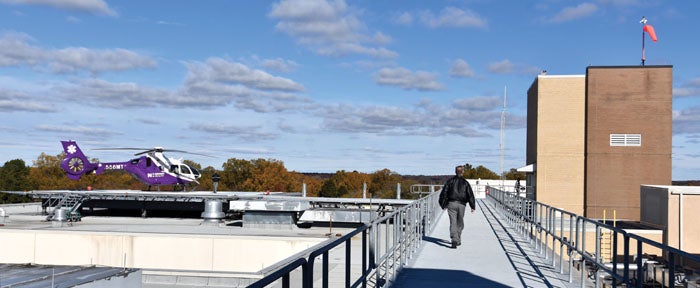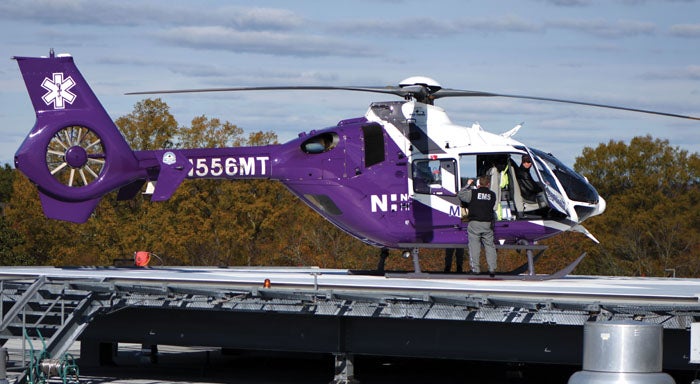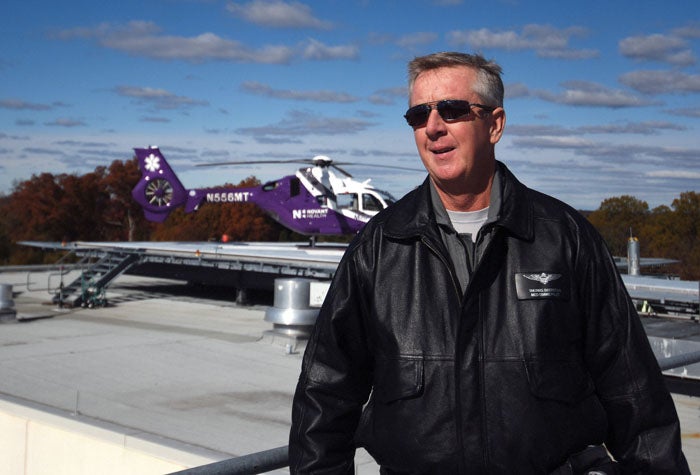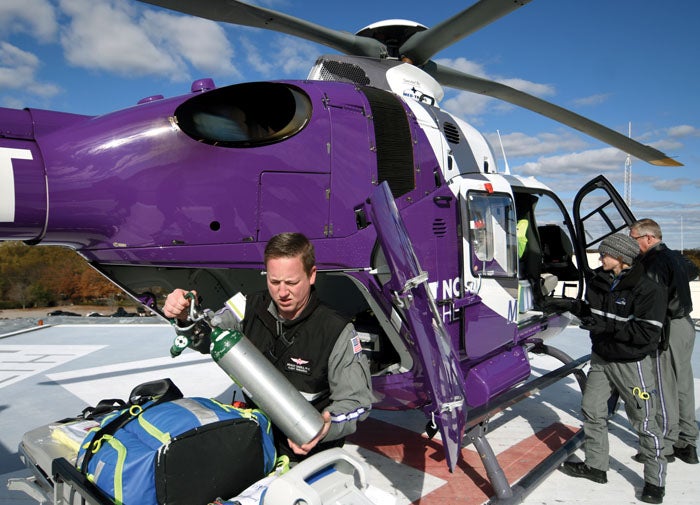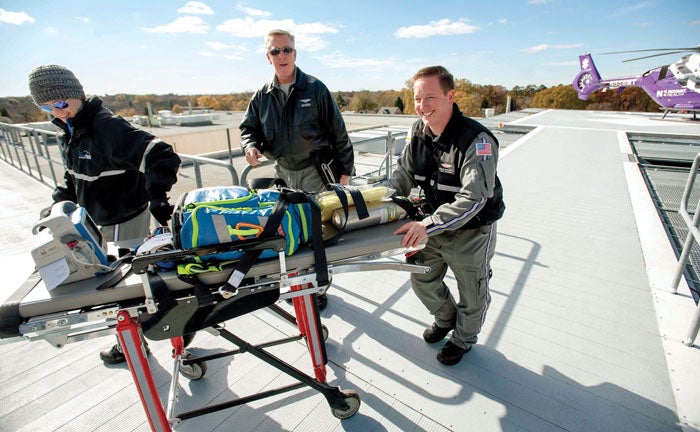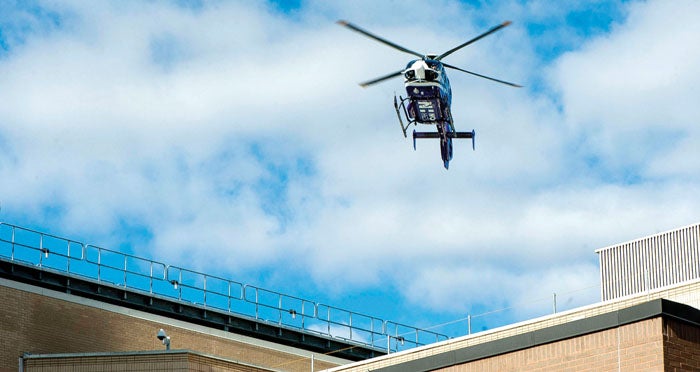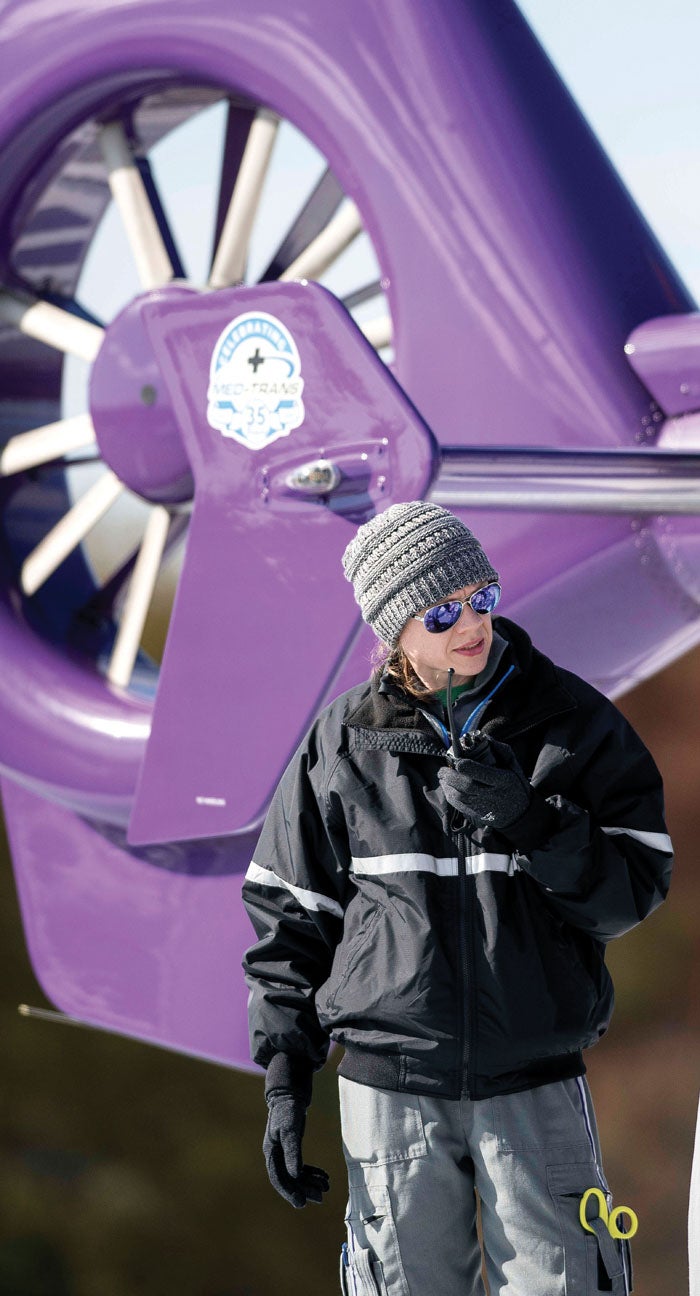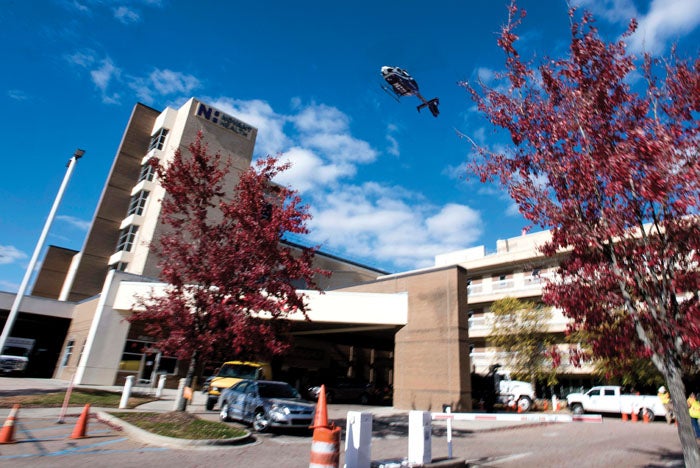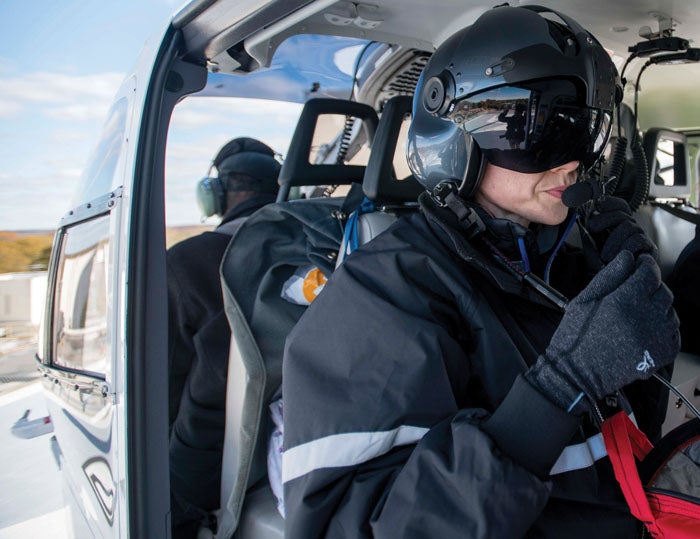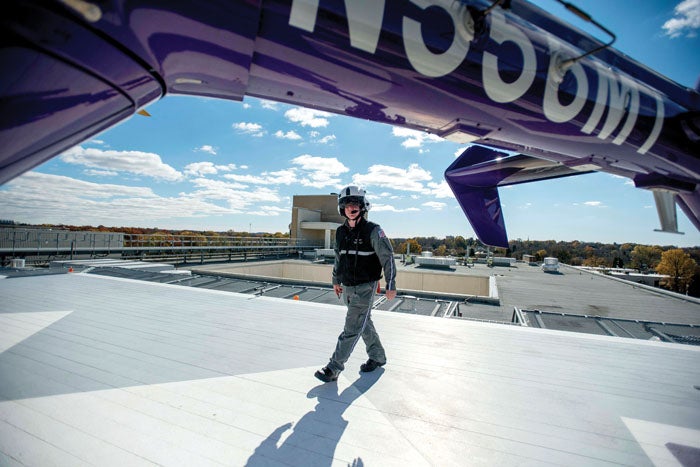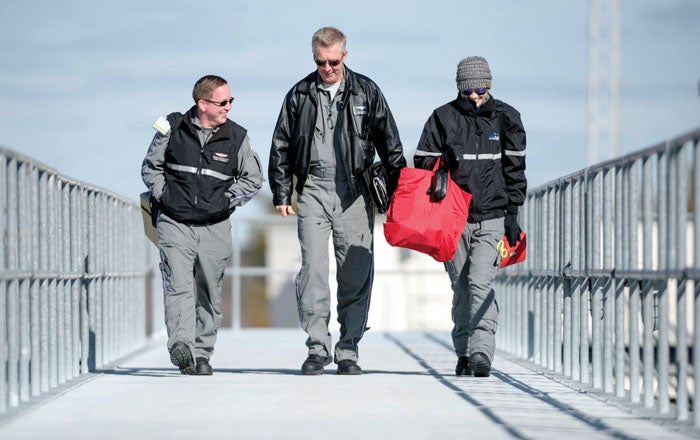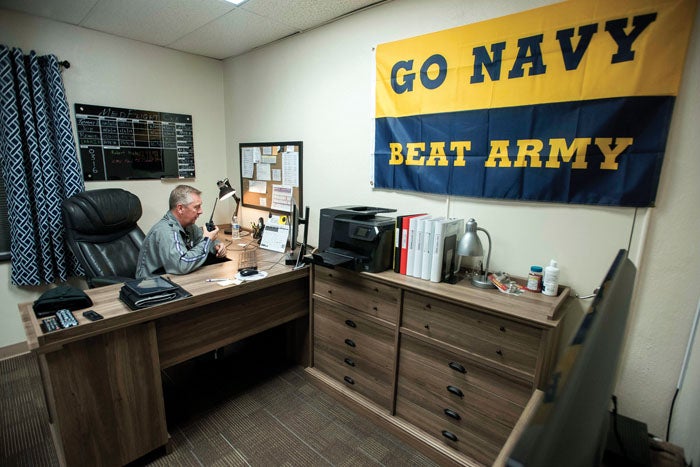On call all the time: Novant’s air medic team always prepared for emergencies
Published 12:10 am Thursday, December 13, 2018
By Maggie Blackwell
For the Salisbury Post
SALISBURY — When someone suffers a heart attack or stroke, an air medic team can mean the difference between life and death. Some auto accidents occur far enough away from a hospital that an ambulance cannot reach the patient — or the hospital — quickly enough. For critically ill and injured patients, air medics can mean the difference between life and death.
Novant Health Rowan Medical Center started an air medic program just a little over a year ago, and they’re available 24 hours a day, seven days a week. Every flight is managed by a pilot, paramedic and a nurse in an ICU in the air.
The crew isn’t just “on call.” Much like firefighters, they live, during their shifts, in a small home that’s been converted to accommodate their unique live/work needs. The home is just steps away from the hospital’s helipad.
The house features a common area, a pilot office, three small bedrooms, restrooms, a kitchen and storage. It’s all squeezed into 1,600 square feet, tight quarters for professionals on a 12- or 24-hour shift.
The professionals travel to work in Salisbury from as far away as Virginia. Shift change occurs at 7 a.m.
On a recent weekday, staff included Tom Brereton, base aviation manager and pilot; Russell Wise, program manager, Laura Shaw, flight nurse, and Bradley Daniels, base medical manager and flight paramedic.
Laura, the certified flight nurse, has a petite frame and sports her androgynous flight suit like a model. She exudes an aura of calm and professional confidence.
She visits the helicopter first thing on her shift to inventory supplies and be sure everything is in place. The inside of the helicopter is outfitted with a myriad of pockets, shelves and straps to ensure critical life-saving instruments are all within reach. Syringes, cardiac monitor, gloves, oxygen, dressings, flashlights, stethoscope and blankets are tucked throughout the interior of the bay. The gurney holds a 40-pound knapsack outfitted with intubation, emergency items, suction and other items.
In the evening she makes another trip to the aircraft and ensures the night vision goggles are on the helmets, ready to go.
Laura laughs and says that she’s on her third career. The daughter of a military family, her first vocation was helicopter repair. “I was good at it,” she smiles, “but I did not enjoy the work.”
She married and had children. Inspired by her nurse-midwife, she trained to be a registered nurse. Years later, working in the emergency room, Laura saw a medical flight crew bring in a patient. “Now that’s what I want to do,” she thought, and she pursued additional training to qualify for air medic work.
Bradley, the certified flight paramedic, started working in EMS at age 19. Then he was drawn to flight medicine. “I was a little nervous,” he admits. “Our company requires five years of experience. I had nine years, but…” He pauses to think of his words. “As an EMS you may have one critical case every so often, but in air medical, every case is critical.”
Bradley has soulful eyes that swell with pride as he mentions the 4-year-old son he and his wife recently adopted.
Russell does not fly, but is accountable for the flight teams. He manages them and ensures they have everything they need to serve the public.
He says that this is his third career, too. “My first job was in beverage distribution,” he starts, “and it wasn’t what I wanted to do.” He became a firefighter and paramedic and worked his way up to chief. He started with flight medicine at Med-Trans six years ago.
Med-Trans is the flight medical company that provides service to Novant Rowan Regional as well as over 90 other hospitals in 20 states. Started by a Vietnam veteran, Med-Trans hires, trains and manages personnel to serve critical medical cases by helicopter.
Tom the pilot is tall and lanky, with a very Jimmy Stewart-esque appearance. He started his career at Kings Point in New York, the Merchant Marine Academy. On graduation he accepted a commission in the Navy, attended flight school, and flew for nine years. “I loved every minute of it.”
It required, however, too much time away from family, so he took a job with the FBI. Flying for the bureau part time, he saw an ad for pilots to go to Afghanistan and Africa, using the same helicopter he flew in the Navy. For about a year Tom worked in Niger, and then he saw an ad for a pilot position for Novant.
“One reason I went to Africa was to get my helicopter experience up so I might be eligible for a job of this sort,” he says, and the rest is history. “I was not sure I had enough experience, but I applied — and was a little surprised when they offered me the job.”
“When we first got here,” Tom says, “we had new staff, new aircraft and new experiences. We were unfamiliar with many locations. I had to pinpoint the coordinates for every new location.”
Today he has programmed in all those coordinates, so with the entry of a character or two on his computer, everything comes up automatically for about 100 “local” hospitals. He may hear about new locations within his service area, and in his spare time, he enters those coordinates, as well.
The routine
Every morning at 7 a.m., shift change happens. Crew members have computer time and administrative duties. The pilot logs everyone’s weight for the day; a few pounds can make a critical difference in the performance of the helicopter. The aircraft can carry a total of 2,910 kilograms — or 6,415 pounds. In the case of a severely obese patient, Tom may start the helicopter early to burn off a few pounds of fuel. It’s all a balancing act.
The morning briefing covers many topics: special weather conditions, ride-alongs, emergency procedures and how to respond if one should develop. Sometimes there are special events in the area that preclude flight in specific areas, like football games or a presidential visit. If the FAA has blocked airspace, the team discusses what to do. Fellow pilots keep Tom apprised of new barriers to flight, like cranes at construction sites.
As pilot, Tom leads the morning briefing and involves every member of the team. Sometimes inserting humor, sometimes deadly serious, he ensures that all members feel valued. He throws a “topic of the day” into each morning briefing. Today it’s the effect of medication on staff.
One of the many topics in the morning briefing is the weather. As pilot, Tom could certainly be the only voice in whether the environment is safe or not to fly. But he includes everyone on the team. “We have a rule of thumb around here,” he says. “The most conservative vote wins. If one person says we can’t go, we don’t go.”
Once the briefing is complete, it’s time to check out the aircraft. They may take a test flight. Fuel samples are taken. They do everything they can to ensure safe flight can take place. At this time, they also inventory blood products and medications, which are stored in a secure facility.
Anything to save time
Med-Trans does not have goal times for crew to reach the helicopter after a call for service, but advises “calculated response.” To put a number on it, Russell says, would introduce an element of stress in the crew. “We just do everything we can to expedite,” he says. “At the end of the month we receive measures to see how we did.”
In fact, they have concerns if they get there too quickly. “The rule of thumb,” Russell says, “is if the crew is airborne within six minutes, someone may have bypassed safety measures. If it takes longer than fifteen minutes, there was an ‘outlier’ that needs looked at.”
Of course, he adds, with new pilots, “you give a longer leash.”
Tom chuckles as he recalls his first timesaving device. “When I came I wore lace-up boots, similar to what I wore in the Navy. I looked around one day and everyone else had boots with zippers. They were ready to go and here I was, still lacing up. For a while I even slept with my boots on, but it wasn’t long before I bought zip-up boots myself.”
Russell says, “It’s not our time we are saving. It’s the patient’s time.”
A live call
A call comes in: a motorcycle has wrecked and needs helicopter rescue. The team springs quietly into action. They find coats and prepare to leave their quarters for the helicopter. Towering over the other crew, Tom’s long legs take him a good 20 feet ahead of the others.
He has a key to reserve the elevator solely for their use. As he approaches the hospital building, he already has the key in his hand, turned the correct way to insert into the opening. He says later he doesn’t want to waste seconds fumbling to get it in correctly.
The crew silently files in. It’s a quiet ride to the top of the building. At the top, security staff is waiting on the team. Tom quickly updates them and the crew approaches the helicopter, where maintenance staff are getting everything ready. They’ve already untethered the copter and disconnected the warmers that keep all the fluids ready to go in cold weather.
Tom and the maintenance staff walk around the copter deliberately, inspecting every screw. They discuss little.
When Tom is satisfied with the physical exterior, the flight crew climbs aboard and he starts it up. They are off to save another life.
Tom’s rule of thumb is, no talking during takeoff or landing. If you must speak, it should be brief, and it should be necessary. If it’s humor, it had better be funny. He says it all with a smile.
In the air, everyone has a voice. Small stickers, the type you get at a hardware store to put on a mailbox, are positioned on the windows. The windshield is “twelve,” one side window is “three” and the other is “nine.” The rear of the aircraft is “six.” These indicate the clock positions so a crewmember can let the pilot know, “Birds at nine o’clock, well below us.”
The crew knows by now how long it takes to get to the regional hospitals. Once they’re airborne, getting to Winston-Salem area takes 13 minutes. Charlotte, 16.
On return, the crew reflects on one essential class offered by Med-Trans: Crew Resource Management. “It’s easy,” Tom says, “to have tension working in such close quarters. You can have a difficult patient or weather. Every person must exactly know his job, be willing to help out, must be willing to speak up, and must know his voice will be heard. A big part of that is having a valued voice, knowing you can speak up, taking into account other’s opinions. We always say, ‘Check your ego in the car.’ We come in prepared to grow and improve.”
CRM teaches employees the difference between being assertive and aggressive, and encourages new ideas.
“There’s always something new we can learn from a float (substitute) pilot or nurse from another program,” he says, and points to the wooden suggestion box in the common room. There’s a plastic sleeve on the front with $20 bills in it. “Every week we put another $20 in there. If someone makes a worthy suggestion, they get the pot, and we start over with another $20. We are trying to foster inventiveness and people continuing to think of ways to do things better every time.”
It’s easy to wonder about staff being on the ready for 24 hours: when is the helicopter maintained? When do they sleep?
Russell explains that copters are due for scheduled maintenance based on how many hours they have in the air — so the work is easily scheduled ahead of time. “We often schedule maintenance during bad weather, when we couldn’t fly anyway.” Mechanics are on call 24/7 for anything out of the ordinary.
As Bradley gives a tour of the house, he mentions that Med-Trans encourages staff to take a nap around 2 p.m., because “you never know when you’ll be up all night.”
“We get to do something very few people get to do,” Laura says. “Giving someone the gift of time with their families is a big gift. Some of the larger hospitals can do amazing things. Often they’ll tell us, ‘Hey, the patient is doing well!’ — and that’s a miracle. We get to see it every day.”
Bradley chimes in. “Many times I come into work thinking, ‘I hope I get to be a blessing to someone today’ — but usually we are the ones who are blessed.”
Tom, ever the professional, saves his lead line for last. “I came to know about air medics when my wife was in an accident 22 years ago. She died. They were so kind to my daughters and me, I decided that day I wanted to work towards this qualifying to be a medical pilot. And I did it. It’s very gratifying.”


